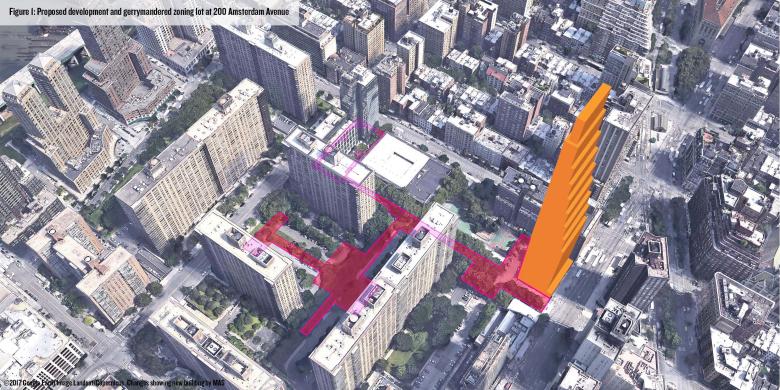Judge Invalidates Tall Tower in NYC
A judge has ruled that the "gerrymandered" zoning lot for 200 Amsterdam Avenue, a residential tower that topped out at 668 feet last summer, is invalid and the developer must remove floors to comply with zoning.
Per a celebratory press release from the Municipal Art Society of New York (MAS), on February 13, "New York County Supreme Court Justice W. Franc Perry issued a decision striking down the legitimacy of the gerrymandered zoning lot at 200 Amsterdam Avenue. The case, an Article 78 proceeding brought by the Committee for Environmentally Sound Development (CFESD) and the Municipal Art Society of New York (MAS) against the New York City Board of Standards and Appeals (BSA), argued that the 39-sided lot that gave rise to the tower is in violation of zoning and should never have been approved."
The zoning lot the developer created to add more floors than allowed otherwise is a convoluted one, snaking between residential slabs. "Gerrymandered" is an apt words, since the outline resembles the gerrymandered maps of congressional districts in U.S. politics. The lot for 200 Amsterdam is best understood in a diagram MAS created as part of its case:
The ruling basically says that SJP Properties and Mitsui Fudosan America, the tower's developers, must remove around what could be 20 floors from the top of the 52-story building to comply with zoning calculations sans the gerrymandered extension. If they will actually do so is unclear. The developers, working with Elkus Manfredi Architects, had gained the proper approvals from the Department of Buildings before construction so have vowed to appeal the ruling. Furthermore, the units affected are the most expensive, including a $21 million penthouse with Central Park views.
Yet as the New York Times points out in its story on 200 Amsterdam, removing floors from completed buildings is not unheard of in NYC: In 1991, 12 floors were removed from the top of a 31-story apartment building on the Upper East side that exceeded its zoning requirements. Options were explored as alternatives to demolition, though, including renovating adjacent apartments for elderly housing. Most likely the ruling for 200 Amsterdam will lead to a number of creative alternatives to removing the valuable real estate atop the tower.

